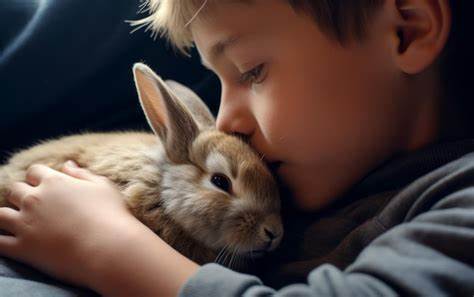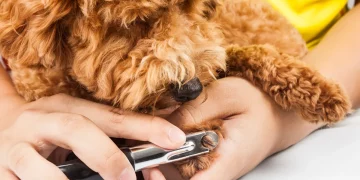Building Trust with Your Rabbit
Understanding Rabbit Behavior
Natural Instincts
Rabbits are prey animals, and their behavior is heavily influenced by this fact. Understanding their natural instincts is crucial in building trust. They are naturally cautious and may take time to warm up to new environments and people.
Body Language
Rabbits communicate a lot through body language. Learning to interpret their signals can help you understand their feelings and respond appropriately. For instance, a relaxed rabbit might stretch out comfortably, while a tense rabbit may flatten its ears against its body or thump its hind legs.
Creating a Safe Environment
Safe Space
Providing a safe and secure environment is the first step in gaining your rabbit’s trust. A designated area where your rabbit can retreat and feel safe is essential. This can be a spacious cage, a playpen, or a rabbit-proofed room.

Hideouts and Comfort
Ensure your rabbit has access to hideouts, such as tunnels, boxes, and cozy corners. These provide a sense of security and allow your rabbit to relax and observe without feeling exposed.
Gentle Introduction
Allowing Time to Adjust
When you first bring your rabbit home, give it time to adjust to the new environment. Avoid overwhelming your rabbit with too much interaction initially. Allow it to explore its new surroundings at its own pace.
Slow Movements
Approach your rabbit with slow, gentle movements. Sudden actions can startle them, reinforcing their fear. Speak softly and move calmly to create a sense of safety.
Building Trust Through Interaction
Hand-Feeding Treats
Hand-feeding treats is an effective way to build trust. Start by offering treats through the bars of their cage or while they are in their safe space. Gradually, encourage your rabbit to take treats from your hand while you are nearby.
Sitting on the Floor
Sit on the floor at your rabbit’s level. This non-threatening position helps your rabbit feel more comfortable and allows it to approach you on its terms. Avoid standing over your rabbit, as this can be intimidating.

Gentle Petting
Once your rabbit feels comfortable around you, you can begin to pet it gently. Start with short, light strokes on the forehead and back. Avoid touching sensitive areas like the belly or feet initially. Pay attention to your rabbit’s body language to gauge its comfort level.
Positive Reinforcement
Rewarding Good Behavior
Use positive reinforcement to encourage desired behaviors. Reward your rabbit with treats, gentle petting, or praise when it approaches you, allows petting, or exhibits calm behavior. This helps your rabbit associate you with positive experiences.
Consistency
Consistency is key in building trust. Regularly spend time with your rabbit, maintaining a predictable routine. Consistent positive interactions will help your rabbit feel secure and develop a sense of trust.
Socialization and Play
Engaging in Play
Engage your rabbit in play to build trust and strengthen your bond. Provide toys such as balls, tunnels, and chew toys to stimulate your rabbit mentally and physically. Interactive play sessions can be a fun way to connect with your rabbit.
Exploring Together
Allow your rabbit to explore new environments under your supervision. Gradually expand their play area, introducing them to different rooms and spaces. This helps your rabbit feel more comfortable and confident in your presence.
Handling and Grooming
Gentle Handling Techniques
Proper handling is crucial for building trust. Always support your rabbit’s body when lifting it, ensuring its hind legs are supported to prevent injury. Avoid holding your rabbit tightly or forcing it into uncomfortable positions.
Regular Grooming
Regular grooming sessions, such as brushing and nail trimming, are essential for your rabbit’s health and well-being. Approach grooming gently and calmly, rewarding your rabbit with treats and praise to make the experience positive.
Understanding and Respecting Boundaries
Respecting Your Rabbit’s Space
Respecting your rabbit’s boundaries is essential for building trust. If your rabbit retreats to its safe space, avoid forcing interaction. Allow it to come to you when it feels comfortable.
Recognizing Signs of Stress
Be attentive to signs of stress, such as excessive thumping, hiding, or aggressive behavior. If your rabbit shows signs of stress, give it space and time to relax before attempting further interaction.
Addressing Behavioral Issues
Identifying the Cause
Behavioral issues can arise from various factors, including fear, stress, or past trauma. Identifying the cause of these issues is the first step in addressing them. Observe your rabbit’s behavior and environment to pinpoint potential triggers.
Seeking Professional Help
If your rabbit exhibits persistent behavioral issues, consider seeking advice from a veterinarian or a professional animal behaviorist. They can provide guidance on addressing specific problems and improving your rabbit’s well-being.
Bonding with Multiple Rabbits
Introducing New Rabbits
Introducing new rabbits to each other requires patience and careful planning. Start by allowing them to see and smell each other through a barrier before allowing physical interaction. Gradually increase their time together, monitoring their behavior closely.
Creating a Harmonious Environment
Ensure each rabbit has its own space and resources, such as food bowls, water bottles, and hiding spots. This helps prevent territorial disputes and promotes a harmonious environment.
Long-Term Trust and Bonding
Ongoing Interaction
Building trust with your rabbit is an ongoing process. Continue to spend quality time with your rabbit, engaging in positive interactions and activities. This strengthens your bond and maintains trust over time.
Adapting to Changes
Life changes, such as moving to a new home or introducing new pets, can impact your rabbit’s sense of security. During these times, provide extra comfort and reassurance to help your rabbit adjust and maintain trust.
Conclusion
Building trust with your rabbit is a rewarding journey that requires patience, understanding, and consistency. By creating a safe environment, engaging in positive interactions, and respecting your rabbit’s boundaries, you can foster a deep and lasting bond. Remember, every rabbit is unique, and the time it takes to build trust may vary. With love and dedication, you can create a strong and trusting relationship with your furry companion.























































